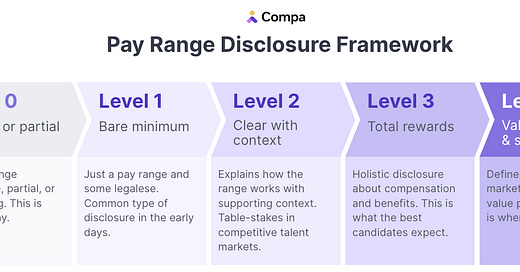A framework for better pay range disclosure
And the inevitable transition from bare minimum to strategic marketing
Pay range disclosure is all over the place.
From my recent conversations with comp leaders, that’s primarily because they are triaging and focusing internal employee communication first.
It’s also because everyone is just trying to figure it out, and it’s easiest to start at the beginning. I expect disclosure will get better over time, just like it did with the Compensation Discussion & Analysis and the CEO Pay Ratio.
When you are ready to up-level your pay range disclosure, here’s a simple framework for quality:
Notice I’m not talking about the pay range spread, but the overall depth of disclosure. Of course, we don't want to see ridiculous $0-$200,000 ranges; but going beyond that, disclosure should be about values, philosophy, policy, and storytelling.
Job postings are marketing for your company, after all.
Here are a few examples of pay range disclosure in each level.
Level 0: Missing or Partial
No pay range disclosure, partial, or misleading

Level 0 is going away. Some organizations just haven’t gotten to updating their job postings yet, even if they were posted after January 1st.
You can still find plenty of these examples, like at Slalom, Databricks, and NetApp. I’m sure these will get ironed out soon — I’m not trying to put anyone on blast.
Level 1: Bare Minimum
Just a pay range and some legalese

Level 1 is the vast majority of pay range disclosure right now, and for most companies, probably will be through 2023 as they wait to see what happens.
There are so many examples — here are a few at New York Times, Mastercard, World Economic Forum, Starbucks, Holland America, and Vail Resorts.
Level 2: Clear with Context
Explanation of how the range works with supporting context

Level 2 specifies pay details clearly, like applicable locations, what factors drive positioning in range, and additional rewards eligibility.
Notice the salary range may not be particularly instructive — in this example at Zillow, the range of $139k-$223k is a fairly wide 60% spread. But it’s covering disclosure for a broad group of markets (Nevada to NYC). And at least the disclosure does the job of answering many questions a candidate would otherwise have to ask the recruiter.
In my view, Level 2 is table-stakes for any company hiring in competitive markets, and indeed appears to be the most common approach for top brands.
More examples at Github, Fred Hutch, Activision Blizzard, Tesla, Genentech, and the National Football League.
Level 3: Total Rewards
Holistic disclosure about compensation and benefits

Level 3 tells the full story, showing candidates information about how each pay element works, with enough detail to build a meaningful picture of what they might earn at your company.
This is what the best candidates expect.
Very few organizations disclose Level 3 detail, which goes far beyond the legal minimum. For most companies, this type of disclosure is verbal, and lives with the recruiter, who carefully chooses what to share and when as she manages candidates through the pipeline towards the offer.
If Level 3 seems daunting, consider linking in the job description to your total rewards career page — you put all that effort into telling your story on your website, so be sure the eyeballs on job postings make it there.
Level 3 examples are rare — Morningstar is the best example I could find. University of San Diego and Gusto both do a good job of linking to total rewards pages with more detail.
Level 4: Values-Driven & Strategic
Define the “why,” and market a differentiated value proposition

Level 4 is all about strategy. Use pay range disclosure to market your compensation philosophy. Describe your commitment to pay equity, and to rewarding top performance. Know how your pay practices differ from your top talent competitors, and highlight your relative strengths.
Disclosure is a tool to win over hearts and minds — and to attract the best talent.
I couldn’t find any Level 4 examples just yet. But it’s surely coming.
Once companies get over the initial thrash of figuring out compliance, they will approach disclosure as a marketing opportunity, just as they did in exec comp with the proxy statement.
Since I couldn’t find any good examples, check out an awesome CD&A from Gilead that shows where pay range disclosure is going on job postings.
Quick plug: webinar this week
This week I’m speaking with Jonathan Lydon, Head of Recruiting at Nuro, about leveraging pay transparency to improve talent acquisition.
All these new regulations have a big impact on recruiters and how they do their jobs. I’m really excited to talk with Jonathan about his team’s experience adapting to the new policies in California, and what the response has been like from candidates.
If you’re free at 11am Pacific on Thursday 1/12, come join us for the conversation.
Peer Group is a newsletter for comp leaders navigating the new era of pay transparency. If you want to share my newsletter, you can forward this email to your colleagues and fellow comp leaders.
Want more polls and insights about pay transparency?
Subscribe by hitting the button below.



